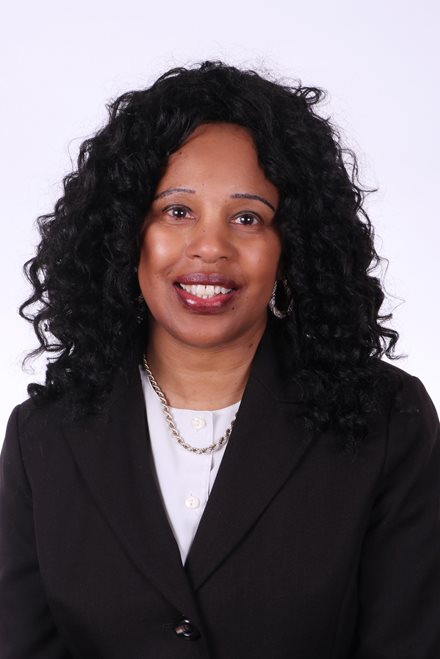Employment is something individuals who are blind or visually impaired experience challenges with all the time, particularly those who have a progressive eye condition.
It’s something Janet LaBreck knows about first-hand.
Diagnosed at the age of 10 with retinitis pigmentosa, LaBreck is one of six siblings suffering from the degenerative progressive condition, which has no cure.
 It was just one of the aspects of blindness and low vision that LaBreck addressed during her virtual talk, “Sometimes in Life, Adversity and Barriers Can Become a Pathway to Opportunity” Oct. 28 as part of the University’s Diversity, Equity and Inclusion (DEI) committee’s advocacy and ally ship Lunch and Learn series focused on individuals with disabilities.
It was just one of the aspects of blindness and low vision that LaBreck addressed during her virtual talk, “Sometimes in Life, Adversity and Barriers Can Become a Pathway to Opportunity” Oct. 28 as part of the University’s Diversity, Equity and Inclusion (DEI) committee’s advocacy and ally ship Lunch and Learn series focused on individuals with disabilities.
The concept of whether or not one with blindness or low vision is encouraged to work, or whether or not one has a desire to work but doesn’t necessarily have the specific skill set needed for a job, were taught to LaBreck when she attended the Perkins School for the Blind in Watertown, Massachusetts, as a youngster.
“Perkins really helped me to feel confidence and to understand that in spite of the fact that you can’t do something the same way as someone else, it doesn’t mean that you are any less of a person,” she said. “And, it doesn’t mean that you can’t acquire those specific skill sets as an individual and perform those functions, it’s just that you’re using an alternative approach.”
LaBreck stressed the need for blind and low vision individuals to have a strong support system, a counselor or peer group, to understand they are not alone on their journey.
Expectations play a critical role as well. As a child, LaBreck was not expected to perform the work that her peers were performing because of her disability. She wasn’t expected to join in on the playground or to do certain parts of the classwork assignments, mostly because her early-years teachers didn’t know how to teach her to perform those tasks.
“What happens to an individual who is losing their vision and living with vision loss is that they think about the perception of themselves,” said LaBreck. “Am I going to date? Am I going to be asked to the prom? Am I going to be able to drive? Those are things that young people think about and experience and that their peers experience.”
She added it is incumbent on the educational institutions themselves to change the approach and make sure expectations for those who are blind or have low vision are not lowered.
LaBreck also discussed how the current pandemic has had a bit of a silver lining for those with disabilities in that it has given many the opportunity to work from home.
“It has shown us that when you’re thinking about strategies and accommodations, there are lots of opportunities for innovation and flexibility,” she said. “That there are ways to navigate through the process. And, that it takes communication, understanding, flexibility, and motivation on both sides of the equation to really support and encourage the success of these individuals.”
Even then though, the pandemic has heightened the sense of stress and anxiety this population deals with on a daily basis. LaBreck specifically cited access to food as one example.
“We know that food security is an issue in general for the disability community, just being able to have the access to go and get food,” she said. “The pandemic compounded that issue.”
These are issues that are critical in understanding how to work with individuals with these types of disabilities.
“Oftentimes we’re not thinking about the population that we’re serving from a holistic approach, how do all of these elements come together to really reflect the experience they’re having, both in the classroom and post-secondary education experience,” said LaBreck.
During the question-and-answer portion of the presentation, LaBreck was asked how the University can best advocate for underrepresented groups who also have disabilities and is there a difference in doing so.
“There is a difference, and that difference reflects back to your understanding of who that underserved population is. It also gets reflected in does the workforce have the individuals available that reflect that underserved population?” she said. “If we have an underrepresented amount of individuals working with people who are visually impaired who are not representing those underserved populations, then how do you expect to serve that population?”
LaBreck closed with advice on improving awareness and collaboration between the field of blindness and low visions professionals and healthcare providers. She stressed the importance of collaboration and partnership when navigating the healthcare system.
“Having the opportunity to collaborate and partner with the healthcare system is not only innovative, but it goes a long way for changing that paradigm of both how individuals are received and how they are treated when they enter a healthcare system,” said LaBreck.
According to LaBreck, individuals with disabilities often become ambassadors within the healthcare system, which takes a lot of work.
“But I think that it is well worth it and goes a long way to changing both the expectations, the experiences and the outcomes,” she said. “Because you’re much more likely to have a successful outcome if people experience the overall treatment process as an inclusive and engaging one.”